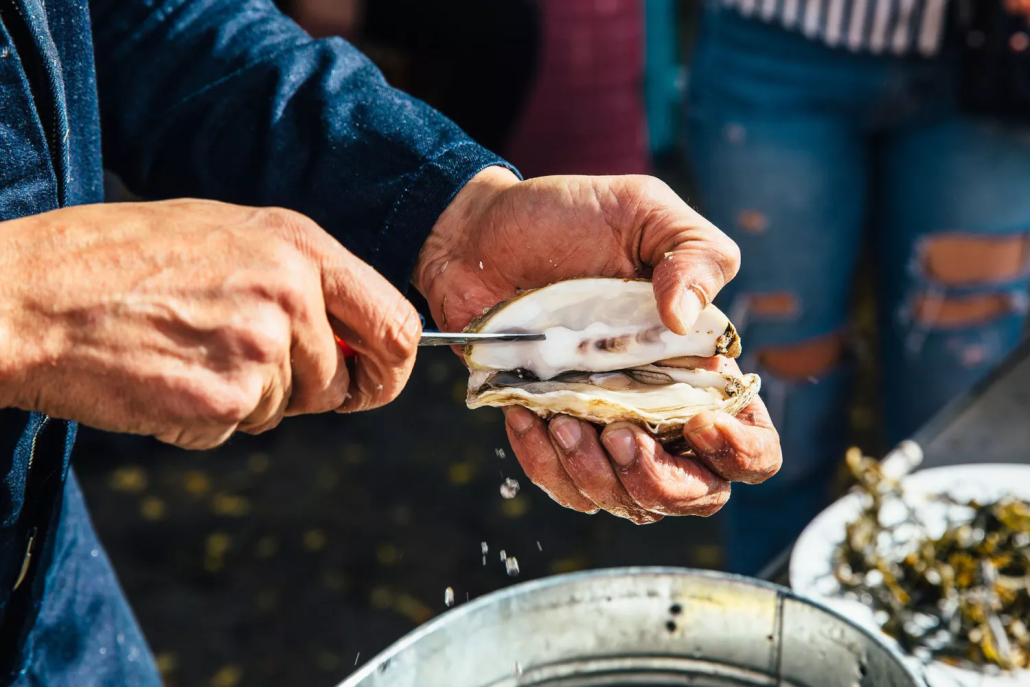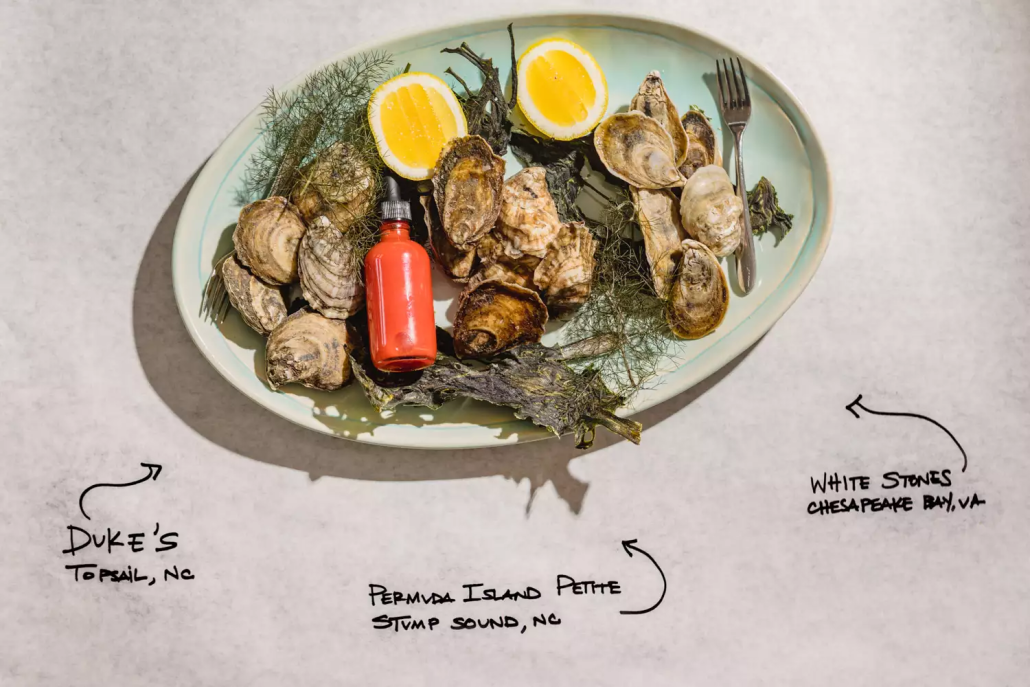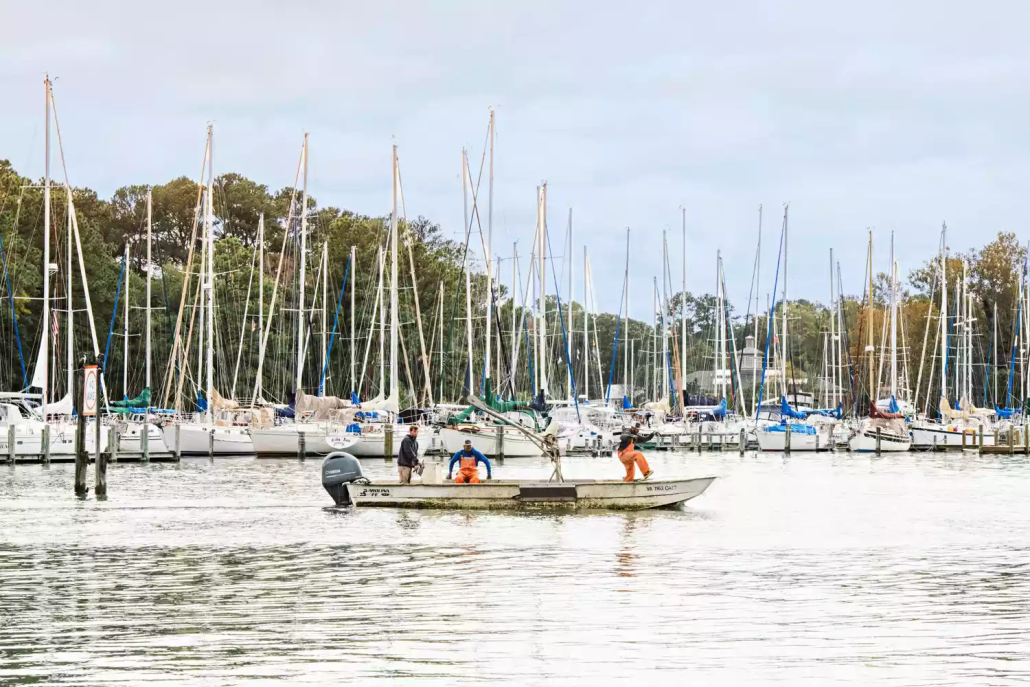The South’s Oyster Trails Are Drawing Hungry Crowds
Turning appetite into agritourism.
by Carrie Honaker on September 25, 2022 | Reprinted from Southern Living

Oysters tell stories. The narrative begins as each is pried open, shucked from its shell, and slid into a waiting mouth. There, you’ll taste hints of where it grew, how many times the farmer touched and tumbled it, the salinity of the water, food consumed, weather endured. All of it’s there, the story of the farmer, their life, their home, and the hours on the water tending their crop.
Oyster trails, a new leg of culinary travel, invite visitors to learn about the deep history of these rural, coastal communities, see working oyster farms, and sample the briny bivalves at restaurants who support them.
North Carolina Oyster Trail
In 2020, the North Carolina Oyster Trail launched, offering up farm tours, “voluntourism” activities to protect oyster habitats, and tasting opportunities. “Our interactive map shows options to visit seafood restaurants serving local oysters and oyster farm tours to see how North Carolina oysters are grown,” says Dr. Jane Harrison, coastal economics specialist with North Carolina Sea Grant. “You can visit an education organization like North Carolina Coastal Federation that’s dedicated to protecting and restoring our coastal environment. The oyster trail isn’t just about eating oysters—although that’s one of my favorite parts—there’s an ocean of possibilities.”
At Down East Mariculture, a mosaic mural by local artist LaNelle Davis adorns the side of the once condemned Willis Brothers Seafood building. The mural (based on a photograph) shows Lula Willis Fulcher, Rena Wade Piner, and Lela Thomas opening clams back in the 1950s. Davis hand-cut dishes contributed by families who worked at the clam house, and the shells on the wall were excavated from the property grounds.
The artwork embodies the deep history of Down East, a rural area once an economic hub. “When visitors stop here, I talk to them about the history of seafood processed here as early as 1939. Elmer Willis was ahead of his time—he received food science awards from NC State, provided all the clams for Heinz Soup and Campbell’s clam chowders after World War II. He was also one of the first to start blast freezing individual frozen food items, opening a whole new market. We have remnants of the liquid nitrogen room still onsite,” says Susan Hill, co-owner of Down East Mariculture.
Stops like Ghost Fleet Oyster Co. offer sunset boating excursions out to the farm augmented by sea stories about the historical importance of oysters to the coastal environment. “It’s a self-guided adventure that can go in 100 different directions. We talk about gear types, the challenges of oyster farming, how different salinities create flavors. We talk about merroir. We educate visitors to feel confident they have all the tools for a full oyster experience when they arrive at a restaurant on the trail,” says Cody Faison of Ghost Fleet Oyster Co.
The next stop could be PinPoint in Wilmington to sample what Chef Cameron Garvey cooks up with the Faison’s oysters, like the peach basil mignonette made with a white peach sour from a local brewery, or the baked oysters with pepper jelly, braised pork belly, and corn bread crumb. “During the lineup every day, I’ll pop a couple oysters so I can relate the tasting notes, size, shape, anything that helps servers talk to customers about them,” Garvey said.

And if you happen to be there during Green Gill season, you’re in for a geographically rare treat. Oysters with green gills only happen in two places in the world: North Carolina and the clay ponds in Marennes-Oléron, France. Haslea osteria algae creates a vibrant gill in French fines de claires, and for a short period of colder months, that same delicate color occurs in some North Carolina oysters.
James Beard Foundation-nominated Chef Dean Neff at Seabird in Wilmington wants to give guests an experience, “…of where we live though oysters and some of the ingredients we put into the sauces, making it unique, but also familiar and accessible.” Neff serves the bivalves with a Champagne mignonette he augments with local, seasonal ingredients like green coriander from a farmer in Southport. He also crafts a cocktail sauce with a fermented pepper mash sambal that, depending on seasons, includes fruit like loquat, peach, or even plum.
Chef Neff ensures servers at Seabird are equipped to talk about the provenance of the oysters on the menu. Neff elaborated, “These farmers walk in the door, sometimes in the middle of service, right off of their lease with bags of oysters that were in the water hours before. That is exactly what oysters are supposed to be, a time capsule of the environment, pulled directly from the ocean, brought here for people to experience that specific location with its tides, amount of rainfall, husbandry. You know what you’re eating, where it’s coming from, who farmed them, and see that progression—it makes eating the oysters more meaningful.”
Virginia Oyster Trail
One state north, Virginia’s Oyster Trail features stops like Big Island Aquaculture in Hayes where visitors hear the history of Guinea Watermen, learn about the waterways, and handle the gear in between bites of raw and chargrilled oysters. Or you can opt for an experience organized around pairing local beer or wine and curated oyster preparations at restaurant trail stops through Taste Tidewater.

Virginia’s trail, the first in the Southeast, highlights the rural coastal communities through farm tours, lodging, outdoor adventure, art, and restaurants devoted to Virginia oysters. “We want to educate people about how important oysters are to our environment. For the Chesapeake Bay, every oyster filters 50 gallons of water a day, removing the excess nitrates, and helping to improve the water quality,” says Bruce Vogt, Virginia Oyster Trail President.
A unique aspect of this trail is the established tasting regions. Researchers from Virginia Tech University sampled oysters all over the state and identified tasting profiles for the eight coastal regions, much like wine terroir. Flavors range from mellow and buttery, to salty, to slight minerality, to sweet.
Georgia Oyster Trail
Moving south, Georgia is set to launch their Georgia Grown Trail 17 in fall 2022. This trail adds Gullah Geechee heritage to the oyster experience as it travels through the congressionally-designated national heritage corridor across farm tours, restaurants, and cultural hubs like the Savannah-Ogeechee Canal Museum and Nature Center. According to Gullah Geechee Scholar and Trail President Dr. Patrick Holladay, the oyster trail will amplify Georgia’s sustainable seafood industry, as well as educate visitors on the concept of environmental stewardship, and the historic foodways of its coastal communities.
Soon visitors can explore historic seafood regions like Harris Neck and see family farms like E.L Mcintosh & Sons where generations have worked the water. They put the first farmed oysters in Georgia water in 2018. You may recognize Earnest Mcintosh Sr. from an episode of Netflix’s Chef’s Table. Savannah native and James Beard Award winning chef Mashama Bailey spent time on the oyster farm exploring the legacies of African Americans in the Lowcountry.
“When you talk about a food system, you’re talking about people’s livelihoods, and understanding where food comes,” Holladay says.
Oyster trails provide a window into life along the Southeastern coast and an opportunity to sample the bounty produced by farms, artists, chefs, and Mother Nature.




